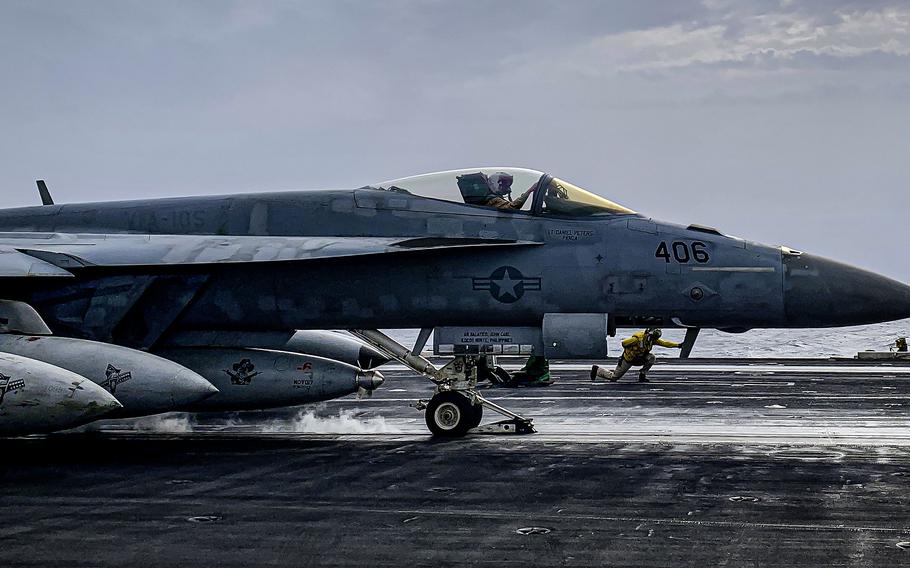
An F/A-18 Super Hornet prepares to launch from the USS Dwight D. Eisenhower in the Red Sea on March 19, 2024. (Alison Bath/Stars and Stripes)
NAPLES, Italy — Recovery of a Navy fighter jet recently downed over the Red Sea likely hinges on what’s left of the wreckage and how safely a salvage operation could be pulled off, analysts say.
The F/A-18 Super Hornet launched from the aircraft carrier USS Harry S. Truman was shot down by apparent “friendly fire” from the guided-missile cruiser USS Gettysburg on Dec. 22. Although the jet is being phased out, newer Block III versions of it have equipment upgrades that could be a tempting target for adversaries.
It’s unknown whether the F/A-18 in question was a Block III or had been outfitted with the newer technology, which includes an infrared system useful in pinpointing stealth aircraft, better radar equipment and a precision approach landing system.
“There would perhaps be sensitive material onboard … worth recovery, but it depends on the condition of the aircraft and where it went down in the Red Sea,” said Steven Wills, a naval analyst with the Center for Maritime Strategy at the Navy League of the United States.
The aircraft may have been largely destroyed, so it’s uncertain how much might be left to recover, he said.
“Much of the Red Sea is relatively shallow ... but there are some deep trenches that are very deep,” he said. “The U.S. has recovered downed intact aircraft in the past, but recovery of wreckage perhaps strewn over miles of seabed would be a challenge.”
The Navy would not say whether it’s considering a recovery effort, referring questions to U.S. Central Command, which cited the ongoing investigation in declining comment.
If a fifth-generation fighter were lost, the Navy would almost certainly seek to retrieve it. When an F-35C fighter attempting to land on the aircraft carrier USS Carl Vinson crashed and slipped into the South China Sea in January 2022, the Navy announced it was working quickly to find the $103 million jet.
The plane was recovered about 37 days later from a depth of 12,400 feet. That operation included a remotely operated diving vehicle and crane from a diving support construction vessel, Stars and Stripes reported in March 2022.
In August 2022, a Block II Super Hornet was recovered in the Mediterranean Sea after it blew off the deck of the aircraft carrier USS Harry S. Truman during a storm the month before.
In that case, the jet was recovered from a depth of about 9,500 feet roughly a half-mile from the estimated point where it entered the water in the Ionian Sea, a portion of the Mediterranean that is bounded by Sicily, southern Italy, southern Albania and the western coast of Greece.
But recovery of the jet lost last week over the Red Sea also would be complicated by the threat of Houthi one-way attack drones and anti-ship missiles, said Sal Mercogliano, an adjunct professor at the U.S. Merchant Marine Academy who has served ashore and at sea for Military Sealift Command.
The Houthi campaign against shipping in the Red Sea has been ongoing since November 2023. The risk to U.S. personnel trying to recover the jet is highlighted by the group’s attack on the Greek-flagged oil tanker Sounion in August, Mercogliano said.
More than three months after the attack, Greek officials said crude oil from the ship had been unloaded after the vessel was towed to a location near the Suez Canal.
The operation followed an arduous recovery that included extinguishing fires on the ship set by Houthis after their initial attack, the newsletter The Maritime Executive reported Dec. 4.
While the Navy has salvage ships, “both are in the Pacific and (the operation) would be in an area that would require a great deal of protection,” Mercogliano said.
CENTCOM has released few details about the circumstances of the shootdown, citing the ongoing investigation.
The crew had completed an earlier mission and was responding to an attack threatening the Truman Carrier Strike Group, Stars and Stripes reported last week. Both aviators ejected from the aircraft and were recovered.
The carrier strike group entered the Middle East this month and includes the destroyers USS Stout and USS Jason Dunham, Gettysburg and Carrier Air Wing 1 with nine embarked aviation squadrons.
It’s unclear how many Block III versions of the Super Hornet the Navy has or how many Block II jets have been upgraded with the advanced technology.
Earlier this year, Boeing was awarded a $1.3 billion contract for delivery of 17 Block III F/A-18 Super Hornets and technical data to sustain the fleet.
Delivery of the new jets, estimated to cost about $56 million each, would begin in late 2026, with final delivery no later than spring 2027, the Navy said in a March 19 statement.